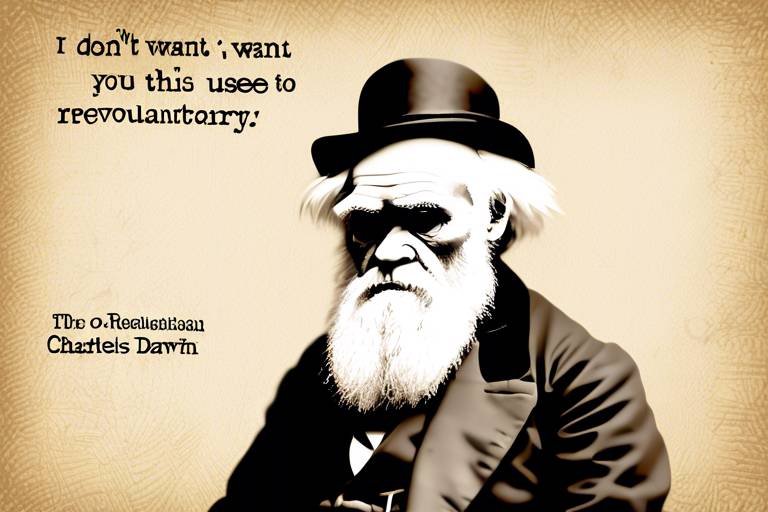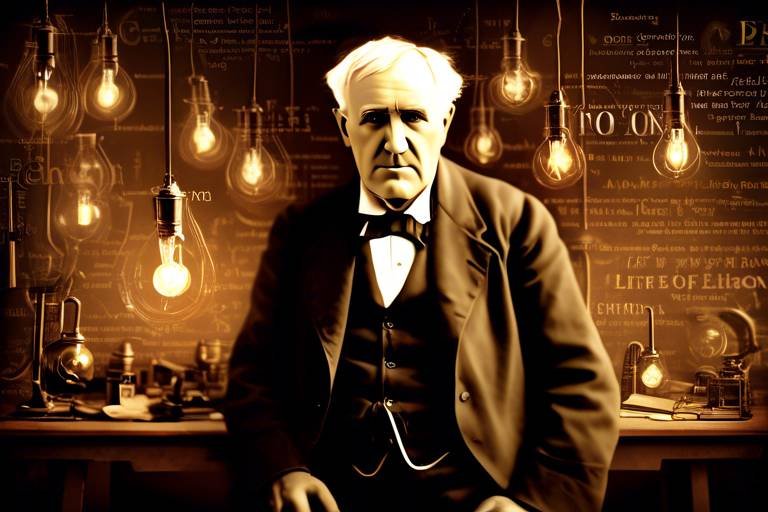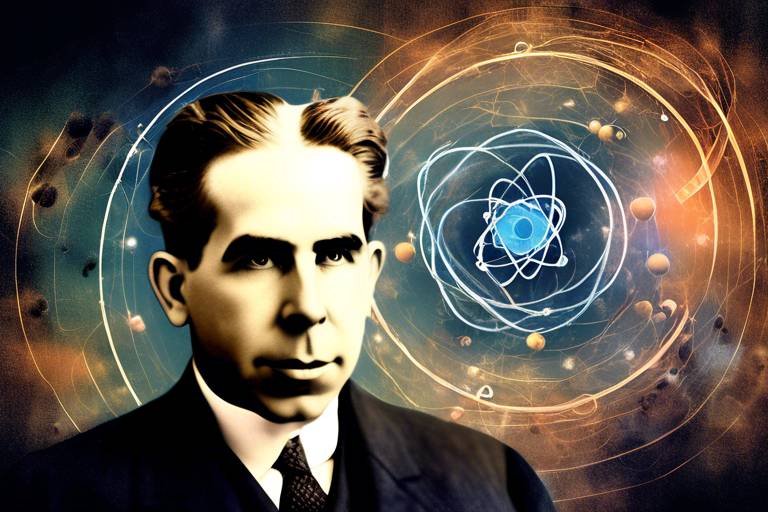Ada Lovelace - The First Computer Programmer
Ada Lovelace, born in 1815, is often heralded as the first computer programmer, a title that reflects her groundbreaking contributions to the world of computing. But what does it mean to be a programmer in the context of the 19th century? At a time when the concept of a computer was merely a figment of imagination, Lovelace was already envisioning a future where machines could do more than just simple calculations. She was a visionary, a woman ahead of her time, and her story is both inspiring and enlightening.
Lovelace's journey into the world of mathematics and computing began with her unique upbringing. Born to an aristocratic family, her mother, Lady Byron, ensured that Ada received an education that was exceptional for women of her time. This education focused heavily on mathematics and science, subjects that would later become the cornerstone of her work. Imagine a young girl, surrounded by the societal norms of the 1800s, breaking through barriers and diving deep into the realms of numbers and logic. This was the foundation that would allow her to collaborate with one of the greatest minds of her era, Charles Babbage.
The partnership between Lovelace and Babbage was nothing short of revolutionary. Babbage was working on his Analytical Engine, a mechanical general-purpose computer that was an audacious leap forward in technology. Lovelace's role in this collaboration was pivotal; she not only understood the intricate workings of the machine but also grasped its potential. In her notes on the Analytical Engine, she articulated ideas that would later become the bedrock of modern programming. It's as if she saw a glimpse of the future, where computers could perform complex tasks beyond mere calculations.
One of the most compelling aspects of Lovelace's work was her introduction of key programming concepts. She was the first to recognize the significance of loops and conditional statements, concepts that are fundamental to programming languages today. To put it simply, she was constructing the very building blocks of programming long before anyone else even thought to lay the foundation. This foresight not only highlights her genius but also emphasizes her role as a pioneer in a field that would grow to dominate the modern world.
Beyond numerical calculations, Lovelace envisioned a world where computers could create art and music, showcasing her innovative mindset. She famously stated that the Analytical Engine could be programmed to compose complex music or produce beautiful graphics. This idea was revolutionary, as it suggested that technology could transcend its traditional boundaries and explore the realms of creativity and expression. Lovelace's vision was a testament to her understanding of the potential of technology, which resonates even today as we see computers being used in creative fields.
Despite her monumental contributions, Ada Lovelace remained largely unrecognized for many years. However, in recent decades, her legacy has been celebrated and acknowledged. Today, she is seen as a trailblazer in computer science, inspiring countless individuals, especially women, to pursue careers in technology and mathematics. Her story serves as a powerful reminder of the importance of diversity in STEM fields and the need for more role models for future generations.
Lovelace's influence on modern computing is profound. Her pioneering ideas have laid the groundwork for the programming languages we use today. In a world dominated by technology, her contributions continue to shape the way we interact with machines and understand their capabilities. As we navigate this digital age, it's essential to recognize the trailblazers like Ada Lovelace, who have paved the way for innovation and creativity in computing.
Today, Ada Lovelace is commemorated through various awards, events, and educational initiatives that celebrate her contributions. Organizations worldwide honor her legacy, promoting awareness of women's roles in the history of technology. These recognitions not only celebrate her achievements but also encourage young women to explore careers in tech, ensuring that Lovelace's spirit of innovation and courage lives on.
- Who was Ada Lovelace?
Ada Lovelace was a mathematician and writer, known for her work on Charles Babbage's Analytical Engine, which is considered the first concept of a general-purpose computer. - What did Ada Lovelace contribute to computing?
She introduced key programming concepts such as loops and conditional statements and envisioned computers' potential beyond mere calculations. - Why is Ada Lovelace important today?
Her pioneering work laid the foundation for modern computing and programming languages, and she serves as an inspiration for diversity in STEM fields. - How is Ada Lovelace honored today?
Various awards, events, and educational initiatives commemorate her contributions and promote awareness of women's roles in technology.

Early Life and Education
Ada Lovelace was born on December 10, 1815, in London, England, to a noble family that had a significant influence on her intellectual development. Her father, Lord Byron, was a renowned poet, while her mother, Anne Isabella Milbanke, was a mathematician and a strong advocate for education. Unfortunately, Ada's parents separated shortly after her birth, and she was raised by her mother, who emphasized the importance of logic and mathematics. This early exposure to analytical thinking was crucial in shaping Ada's future contributions to the world of computing.
From a young age, Lovelace exhibited a remarkable aptitude for mathematics and science, which was quite unusual for women of her time. Her mother ensured that she received a rigorous education, employing private tutors to teach her subjects that were typically reserved for boys. Ada's studies included mathematics, science, and even music, reflecting her diverse interests. It was during these formative years that she developed a passion for numbers and an insatiable curiosity about the world around her.
One of the pivotal moments in her education came when she met Mary Somerville, a prominent mathematician and scientist. Somerville became a mentor to Ada, introducing her to complex mathematical concepts that would later influence her work with Charles Babbage. Their meetings were filled with discussions about mathematics, science, and the potential of machines, igniting Ada's imagination and paving the way for her groundbreaking ideas.
As Lovelace matured, her education continued to deepen. She attended lectures at the University of London and engaged with the scientific community, which was predominantly male. This environment posed challenges, yet Ada thrived, demonstrating her exceptional intellect and determination. By the time she was in her twenties, she had already begun to make significant strides in her understanding of mathematics and computing, laying the groundwork for her future collaborations.
In summary, Ada Lovelace's early life and education were marked by a unique blend of aristocratic privilege and a rigorous academic upbringing. Her mother's influence, coupled with her exposure to prominent intellectuals, allowed her to cultivate a profound understanding of mathematics and science. This strong foundation ultimately enabled her to become the first computer programmer, a title that would resonate through the annals of history.

Collaboration with Charles Babbage
Ada Lovelace's collaboration with Charles Babbage was nothing short of revolutionary. At the heart of this partnership was Babbage's ambitious project, the Analytical Engine, which was designed to be the first mechanical general-purpose computer. Lovelace, with her keen intellect and passion for mathematics, became Babbage's most trusted ally. Their relationship was not just that of a mentor and protégé; it was a dynamic exchange of ideas that pushed the boundaries of what was possible in the realm of computing.
In the early 1840s, Lovelace was introduced to Babbage's work, and her enthusiasm was infectious. She quickly grasped the complexities of the Analytical Engine, which, despite being a theoretical construct at the time, was full of potential. Lovelace's ability to translate Babbage's intricate concepts into comprehensible language was invaluable. She didn't just understand the mechanics; she envisioned the broader implications of computing technology. Her notes on the Analytical Engine, which included a detailed algorithm for calculating Bernoulli numbers, are now recognized as the first computer program.
What truly set Lovelace apart was her ability to see beyond the numbers. While Babbage focused on the technical specifications, Lovelace explored the philosophical implications of their work. She famously stated, “The Analytical Engine does not occupy common ground with mere calculating machines.” This perspective was groundbreaking, as it indicated her understanding that computers could do much more than simple arithmetic; they could create music, generate art, and process complex ideas.
The collaboration was not without its challenges. Babbage was known for his intense personality and sometimes abrasive demeanor, which could be difficult for those around him. However, Lovelace's resilience and passion for innovation allowed her to navigate these challenges effectively. Their correspondence, filled with mathematical equations and visionary ideas, became a testament to their shared ambition.
In summary, the partnership between Ada Lovelace and Charles Babbage was a pivotal moment in the history of computing. Together, they laid the groundwork for modern computer science. Lovelace's contributions were not merely supportive; she was a co-creator, whose insights and foresight opened the door to a future where technology could transcend mere calculation. Their collaboration is a vivid reminder of how teamwork can lead to groundbreaking innovations.
- What was the Analytical Engine?
The Analytical Engine was a proposed mechanical general-purpose computer designed by Charles Babbage, which Ada Lovelace helped to conceptualize and program. - Why is Ada Lovelace considered the first computer programmer?
Ada Lovelace is considered the first computer programmer because she created the first algorithm intended for implementation on a machine, specifically the Analytical Engine. - How did Lovelace's vision differ from Babbage's?
Lovelace envisioned computing as a means to create art and music, while Babbage focused primarily on numerical calculations and mechanical design. - What impact did Lovelace's work have on future generations?
Lovelace's work laid the foundation for modern programming languages and inspired countless individuals, especially women, to pursue careers in technology and mathematics.

Understanding the Analytical Engine
The Analytical Engine is often hailed as the world's first mechanical computer, and its conception marked a pivotal moment in the history of technology. Designed by the brilliant inventor Charles Babbage in the early 19th century, this groundbreaking machine was not merely a calculator; it was envisioned to perform any calculation that could be expressed mathematically. Imagine a machine that could not only crunch numbers but also follow complex instructions—this was the essence of the Analytical Engine.
Ada Lovelace's role in understanding and developing the Analytical Engine was nothing short of revolutionary. She saw beyond its mechanical parts and gears, grasping the profound implications of its potential. While Babbage focused on the engine's design and mechanics, Lovelace delved into the theoretical applications of the machine. She recognized that the Analytical Engine could be programmed to perform a variety of tasks, leading her to formulate the first algorithm intended for implementation on a machine. This foresight is what makes her contributions so significant in the realm of computing.
To better understand Lovelace's insights into the Analytical Engine, let's break down its core components:
| Component | Description |
|---|---|
| Mill | The part of the engine that performs calculations, similar to a modern CPU. |
| Store | A memory unit used to hold numbers and intermediate results, akin to RAM. |
| Input | Methods for feeding data into the machine, such as punched cards. |
| Output | Mechanisms for displaying results, which could include printed output. |
One of the most striking aspects of Lovelace's work was her ability to see the Analytical Engine as a tool not just for calculations but for creativity. She famously stated that the engine could be used to create not only numbers but also music and art. This visionary perspective was revolutionary for her time and laid the groundwork for how we view computers today—as versatile tools capable of a multitude of functions beyond mere arithmetic.
In her notes, Lovelace introduced several key programming concepts that are still relevant today. These include:
- Loops: The ability to repeat a sequence of instructions.
- Conditional Statements: Instructions that allow the machine to make decisions based on certain criteria.
This early understanding of programming concepts showcases Lovelace's unique talent and her ability to think abstractly about technology. Her ideas were not merely theoretical; they were the first steps toward the computer programming languages we use today. In a way, she was like a poet of mathematics, weaving together numbers and logic into a tapestry that hinted at the future of computing.
Ultimately, Lovelace’s profound understanding of the Analytical Engine's potential not only highlighted her genius but also set the stage for future innovations in computing. Her legacy is a testament to the power of imagination and intellect, reminding us that the seeds of modern technology were planted by those who dared to dream beyond the confines of their time.

Programming Concepts Introduced
Ada Lovelace's work with the Analytical Engine not only showcased her brilliance but also introduced several fundamental programming concepts that are still relevant today. Imagine trying to build a bridge without a blueprint; that's how early computing felt before Lovelace's insights. She effectively laid down the groundwork for what we now recognize as programming.
One of the most significant contributions Lovelace made was the concept of loops. In her notes, she described a method to repeat a sequence of instructions, allowing for more complex calculations. This idea is akin to a musician practicing a scale repeatedly until they master it; loops enable computers to execute tasks efficiently without the need for constant human intervention.
Additionally, Lovelace introduced the idea of conditional statements. These are crucial in programming as they allow a program to make decisions based on certain conditions, similar to how we might choose a route based on traffic conditions. For instance, if you want to get to a destination quickly, you might take a different path if the usual route is congested. This ability to adapt and respond to varying inputs is a cornerstone of modern programming languages.
In her visionary notes, she also hinted at the potential of subroutines, which are essentially smaller, reusable chunks of code that can be executed as needed. Think of them as the building blocks of a house; each block serves a purpose but contributes to the overall structure. This modular approach not only simplifies programming but also enhances code readability and maintainability.
Moreover, Lovelace’s foresight in recognizing the potential of the Analytical Engine to perform tasks beyond mere calculations was revolutionary. She envisioned a future where computers could create music and art, not just solve mathematical equations. This perspective opened the door to a new realm of possibilities in technology, illustrating that programming can be an art form as much as a science.
To summarize, Ada Lovelace's contributions can be encapsulated in the following key programming concepts:
- Loops: Allowing repetition of instructions for efficiency.
- Conditional Statements: Enabling decision-making based on specific conditions.
- Subroutines: Reusable code blocks that enhance modularity.
- Creative Applications: Envisioning computing as a tool for art and music.
Her pioneering spirit and innovative thinking not only shaped the early landscape of computer programming but also paved the way for future generations of programmers to explore the limitless possibilities of technology. Lovelace's legacy is a testament to the power of imagination and intellect, proving that the seeds of innovation can grow into magnificent trees of progress.
1. What is Ada Lovelace most known for?
Ada Lovelace is primarily known for her work on the Analytical Engine and is often referred to as the first computer programmer due to her pioneering notes on programming concepts.
2. How did Ada Lovelace contribute to modern computing?
Her insights into loops, conditional statements, and the potential for computers to perform beyond calculations laid the foundational concepts for modern programming languages and computing.
3. Why is Ada Lovelace considered an important figure for women in technology?
Lovelace's achievements in a male-dominated field highlight the importance of diversity in STEM and serve as an inspiration for women pursuing careers in technology and engineering.
4. Are there any awards named after Ada Lovelace?
Yes, several awards and initiatives celebrate her contributions, including the Ada Lovelace Award, which honors individuals who have made significant contributions to the field of computing.

Vision of Computing Beyond Numbers
Ada Lovelace was not just a mathematician and programmer; she was a true visionary who saw the potential of computing extending far beyond mere calculations. While many of her contemporaries viewed machines as mere tools for arithmetic, Lovelace imagined a world where computers could create, innovate, and inspire. She famously stated that the Analytical Engine could manipulate symbols and not just numbers, hinting at the vast capabilities that lay ahead.
This perspective was revolutionary for her time. Lovelace envisioned a future where computers could compose music, generate graphics, and even produce poetry. She believed that if a machine could be programmed to follow a set of instructions, then it could also be taught to express creativity. In her notes, she wrote about the possibility of using algorithms to generate complex patterns and artistic expressions, effectively laying the groundwork for what we now consider artificial intelligence and creative computing.
To illustrate her visionary thoughts, consider the following table that outlines some of her key insights:
| Insight | Description |
|---|---|
| Symbol Manipulation | Ada believed computers could process symbols beyond numbers, paving the way for complex programming. |
| Creative Potential | She imagined computers creating art and music, showcasing their potential for creativity. |
| Algorithmic Thinking | Lovelace emphasized that algorithms could be used for various applications, not just calculations. |
Her insights were not merely theoretical; they were a call to action for future generations. Lovelace's ideas about the **interconnectivity of technology and creativity** resonate today as we see computers being used in a multitude of artistic fields. From digital art to music production, her vision has become a reality. It’s almost poetic how a woman in the 19th century could see a world where technology and creativity intertwine, a world that we are still exploring today.
In her writings, Lovelace also expressed a profound belief in the potential of machines to augment human capabilities, rather than replace them. This notion is particularly relevant in our current discourse around technology. As we navigate the complexities of artificial intelligence and machine learning, her foresight encourages us to consider how we can harness technology to enhance our creativity and problem-solving abilities.
In summary, Ada Lovelace's vision of computing was not limited to the mechanics of numbers; it was a bold proclamation of what could be achieved when we dared to think differently. Her legacy challenges us to continue pushing the boundaries of technology and to explore its potential to enrich our lives in ways we have yet to fully understand.
- What were Ada Lovelace's main contributions to computing?
Ada Lovelace is credited with writing the first algorithm intended for implementation on a machine, specifically Charles Babbage's Analytical Engine. She also introduced concepts such as loops and conditional statements. - Why is Ada Lovelace considered the first computer programmer?
Her work on the Analytical Engine included detailed notes and algorithms, which laid the foundation for modern programming languages, making her the first to conceptualize programming as we know it today. - How did Lovelace's vision influence modern technology?
Her belief that machines could go beyond calculations to create art and music has inspired countless innovations in fields like artificial intelligence, graphic design, and digital music production. - What is Ada Lovelace Day?
Ada Lovelace Day is an annual event celebrated on the second Tuesday of October, aimed at raising the profile of women in science, technology, engineering, and mathematics (STEM) fields.

Legacy and Recognition
Ada Lovelace's legacy is nothing short of remarkable. For many years, her contributions to the field of computer science were largely overlooked, buried beneath the sands of time. However, in recent decades, there has been a significant resurgence of interest in her work, leading to a well-deserved recognition of her pioneering spirit and intellect. Lovelace's notes on Charles Babbage's Analytical Engine not only outlined the first algorithm intended for implementation on a machine but also showcased her visionary understanding of what computing could become.
One of the most inspiring aspects of Lovelace's legacy is her ability to see beyond the numerical capabilities of machines. She envisioned a future where computers could create art, music, and even literature. This broad perspective is what sets her apart from many of her contemporaries. Today, her name is synonymous with innovation and creativity in technology, and she serves as a beacon for those aspiring to push the boundaries of what is possible.
In recognition of her groundbreaking work, numerous awards and honors have been established in her name. These include:
- Ada Lovelace Day: Celebrated annually on the second Tuesday of October, this day aims to raise the profile of women in science, technology, engineering, and mathematics (STEM). Events are held worldwide to honor women’s contributions to these fields.
- Ada Awards: These awards recognize individuals and organizations that have made significant contributions to the advancement of women in technology.
- Educational Initiatives: Various educational programs and initiatives have been launched to promote STEM education among young girls, inspired by Lovelace's legacy.
Moreover, Lovelace's story has been featured in numerous books, documentaries, and films, further cementing her status as a role model. Her life and work serve as a reminder of the importance of diversity in technology and the necessity of including women’s voices in the narrative of scientific advancement. By shining a light on her achievements, we not only honor her memory but also inspire future generations to dream big and break barriers.
In conclusion, Ada Lovelace’s legacy is one of resilience, creativity, and foresight. Her recognition in modern culture and academia illustrates the profound impact she had on the development of computer science and the ongoing conversation about women’s roles in technology. As we continue to explore the vast possibilities of computing, Lovelace’s vision remains a guiding force, encouraging us to think beyond the conventional and to innovate in ways that can shape the future.
1. Why is Ada Lovelace considered the first computer programmer?
Ada Lovelace is considered the first computer programmer because she wrote the first algorithm intended for implementation on Charles Babbage's Analytical Engine, making her the first to recognize the potential of computers beyond mere calculation.
2. What were some of Ada Lovelace's contributions to mathematics?
Lovelace made significant contributions to mathematics, particularly in the field of algorithm development. Her notes on the Analytical Engine included concepts that would later become foundational in programming, such as loops and conditional statements.
3. How has Ada Lovelace's legacy influenced women in technology?
Ada Lovelace's legacy serves as an inspiration for women in technology by highlighting the importance of diversity in STEM fields. Her achievements encourage women to pursue careers in programming and engineering and to contribute to the tech industry.
4. Are there any events that celebrate Ada Lovelace's contributions?
Yes, Ada Lovelace Day is celebrated annually to honor her contributions and to raise awareness of women's roles in STEM. Various events and educational initiatives take place globally to commemorate her legacy.

Influence on Modern Computing
Ada Lovelace's influence on modern computing is nothing short of revolutionary. Her visionary ideas laid the groundwork for what we now recognize as computer science. Imagine a world where the concept of programming was non-existent; Lovelace, with her incredible foresight, saw beyond the limitations of her time. She wasn't just thinking about numbers; she was dreaming up a future where machines could perform complex tasks, create art, and even compose music. This was a radical departure from the traditional view of computing as merely a tool for calculation.
One of the most significant aspects of Lovelace's contributions is her understanding of algorithms. She wrote what is considered the first computer program, an algorithm designed to be executed by Charles Babbage's Analytical Engine. This wasn't just a simple task; it was a complex series of instructions that required a deep understanding of both mathematics and the potential of machines. Her notes contained insights about how to manipulate data and control the flow of operations, concepts that are foundational to modern programming languages.
To illustrate her impact, let’s take a look at some key programming concepts that Lovelace introduced, which are still relevant today:
| Programming Concept | Description | Modern Equivalent |
|---|---|---|
| Loops | Repetitive execution of a set of instructions | For, While loops |
| Conditional Statements | Executing instructions based on certain conditions | If-Else statements |
| Subroutines | Breaking down tasks into smaller, manageable pieces | Functions, Methods |
Her ability to visualize the potential of the Analytical Engine extended far beyond mere calculations. Lovelace imagined a future where computers could handle complex tasks that would enhance human creativity and productivity. This perspective was groundbreaking; it opened the door to the development of software that could perform a variety of functions, from word processing to graphic design. Today, we see her vision manifesting in technologies like artificial intelligence and machine learning, where computers are not just tools but partners in innovation.
Moreover, her legacy continues to inspire numerous fields, including data science, software engineering, and even digital art. Lovelace's ideas challenge us to think about technology not just as a series of codes and algorithms but as a canvas for creativity and expression. Her story reminds us that the world of computing is not just for the mathematically inclined; it is a domain where imagination and logic intertwine.
As we reflect on her contributions, it’s essential to recognize that Lovelace's influence is not just historical; it is a living legacy that continues to shape our understanding of technology today. Her pioneering spirit encourages us to push boundaries, embrace diversity in STEM fields, and inspire future generations to dream big. In a world where technology is rapidly evolving, Lovelace’s insights serve as a guiding light, reminding us that the possibilities are endless when we dare to think differently.
- What was Ada Lovelace's main contribution to computer science?
Ada Lovelace is credited with writing the first algorithm intended for implementation on a computer, making her the first computer programmer. - How did Ada Lovelace's ideas influence modern programming?
Her insights into loops, conditional statements, and the concept of algorithms laid the groundwork for modern programming languages and practices. - Why is Ada Lovelace considered a role model for women in technology?
Her achievements in a male-dominated field during the 19th century serve as an inspiration for women pursuing careers in STEM, highlighting the importance of diversity in technology.

Role Models for Women in Tech
Ada Lovelace stands as a beacon of inspiration for women in technology, illustrating that the world of coding and mathematics is not just a domain for men. Her groundbreaking work in the 19th century paved the way for future generations, proving that women can be at the forefront of innovation and creativity in tech. Lovelace's story is not just about numbers and algorithms; it’s about breaking barriers and challenging societal norms. She defied the expectations of her time, showing that intellect and creativity know no gender.
The tech industry has often been perceived as a male-dominated field, but Lovelace's legacy serves as a reminder that women have always played vital roles in shaping technology. Her vision extended beyond mere calculations; she foresaw a future where computers could create music and art, thereby broadening the scope of what technology could achieve. This visionary outlook resonates with many women today who are eager to explore the multifaceted applications of technology.
Lovelace's contributions have inspired countless women to pursue careers in STEM (Science, Technology, Engineering, and Mathematics). Today, organizations and initiatives are emerging to support women in tech, encouraging them to take on roles that were once considered unconventional. For instance, mentorship programs and coding boot camps are designed specifically for women, helping them gain the skills and confidence needed to thrive in this dynamic field.
Here are a few key ways in which Ada Lovelace's legacy continues to inspire women in technology:
- Breaking Stereotypes: Lovelace's achievements challenge the stereotype that tech is a male-only domain, encouraging women to pursue their passions without fear of judgment.
- Encouraging Diversity: Her story highlights the importance of diversity in tech, showing that different perspectives lead to more innovative solutions.
- Creating Support Networks: Lovelace’s legacy has inspired the formation of communities and networks for women in tech, fostering collaboration and support.
In conclusion, Ada Lovelace is not just a historical figure; she is a role model for women aspiring to enter the tech industry. Her life and work remind us that with passion and perseverance, women can and do make significant contributions to technology and beyond. As we continue to celebrate her legacy, it is essential to encourage young girls to explore their interests in STEM, ensuring that the next generation of innovators includes a diverse array of voices and ideas.

Commemorations and Honors
Ada Lovelace's contributions to the world of computing and mathematics have not gone unnoticed, and today, she is celebrated in numerous ways that reflect her pioneering spirit and groundbreaking work. From educational initiatives to awards named in her honor, Lovelace's legacy continues to inspire and empower future generations. One of the most notable recognitions is Ada Lovelace Day, celebrated annually on the second Tuesday of October. This day is dedicated to raising the profile of women in science, technology, engineering, and mathematics (STEM) and serves as a reminder of the importance of diversity in these fields.
In addition to Ada Lovelace Day, several awards and honors have been established to recognize the achievements of women in technology. For instance, the Ada Lovelace Award is given to women who have made significant contributions to the field, encouraging others to follow in their footsteps. Furthermore, many universities and organizations have named scholarships and programs after her, aiming to support young women pursuing careers in STEM.
Moreover, Lovelace's influence extends to popular culture and academia. She has been featured in various documentaries, books, and even films that highlight her life and work. These portrayals not only celebrate her achievements but also serve to educate the public about the vital role women have played in the history of technology.
To further illustrate her impact, here’s a brief overview of some key commemorations and honors associated with Ada Lovelace:
| Commemoration | Description |
|---|---|
| Ada Lovelace Day | An annual event celebrating women in STEM, encouraging recognition and support for female contributions to science and technology. |
| Ada Lovelace Award | Award recognizing outstanding women in computing, promoting their achievements and encouraging future generations. |
| Scholarships and Programs | Various educational institutions offer scholarships and programs named after Lovelace to support women pursuing STEM careers. |
As we reflect on Ada Lovelace's remarkable journey, it becomes clear that her legacy is not just about her contributions to early computing; it’s also about the doors she has opened for countless women in technology. Her story serves as a beacon of hope and inspiration, reminding us that with passion and perseverance, anyone can make a significant impact in their field.
- Who was Ada Lovelace?
Ada Lovelace was a mathematician and writer, recognized as the first computer programmer for her work on Charles Babbage's Analytical Engine. - What is Ada Lovelace Day?
Ada Lovelace Day is an annual celebration of women in STEM, aimed at raising awareness and promoting the contributions of women in these fields. - What awards are named after Ada Lovelace?
The Ada Lovelace Award is one such honor, recognizing women who have made significant contributions to computing. - How did Ada Lovelace influence modern computing?
Her visionary insights into programming concepts and the potential of computing beyond mere calculations laid the groundwork for modern computer science.
Frequently Asked Questions
- Who was Ada Lovelace?
Ada Lovelace was a mathematician and writer, recognized as the first computer programmer. She is best known for her work on Charles Babbage's Analytical Engine, where she conceptualized the idea of programming.
- What contributions did Ada Lovelace make to computer science?
Lovelace introduced several key programming concepts, including loops and conditional statements. Her notes on the Analytical Engine laid the groundwork for modern programming languages, showcasing her innovative thinking in the field.
- How did Ada Lovelace's early life influence her work?
Born into an aristocratic family, Lovelace received a comprehensive education in mathematics and science, which was unusual for women of her time. This strong foundation allowed her to collaborate effectively with leading thinkers like Charles Babbage.
- What was the Analytical Engine?
The Analytical Engine was a proposed mechanical general-purpose computer designed by Charles Babbage. It was revolutionary for its time, and Lovelace's work on it demonstrated her understanding of its potential applications beyond mere calculations.
- Why is Ada Lovelace considered a role model for women in technology?
Ada Lovelace's achievements in a male-dominated field serve as an inspiration for women pursuing careers in technology and engineering. Her story emphasizes the importance of diversity in STEM and encourages women to break barriers in these fields.
- How is Ada Lovelace commemorated today?
Today, Ada Lovelace is honored through various awards, events, and educational initiatives that celebrate her contributions to computer science and promote awareness of women's roles in technology.
- What vision did Ada Lovelace have for computing?
Lovelace envisioned computing as a tool for more than just numerical calculations. She imagined its potential to create art and music, reflecting her broad perspective on technology's capabilities and its impact on society.



















